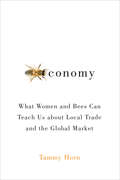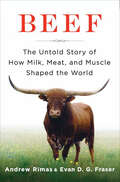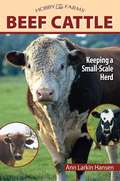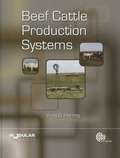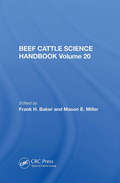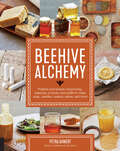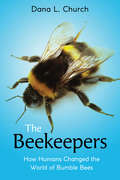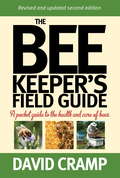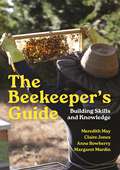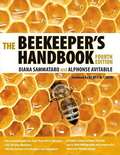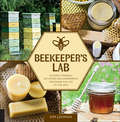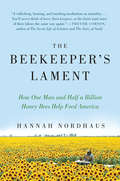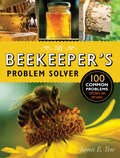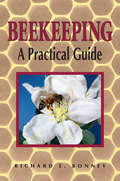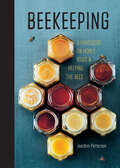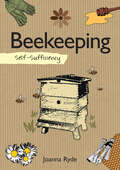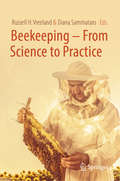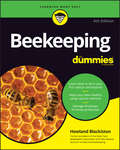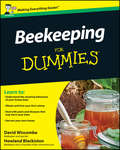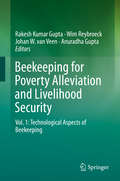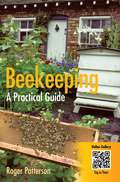- Table View
- List View
Beeconomy: What Women and Bees Can Teach Us about Local Trade and the Global Market
by Tammy HornA fascinating study that &“opens a window on the world of beekeeping and female beekeepers&” (Lexington Herald-Leader). From Africa to Australia to Asia, women have participated in the pragmatic aspects of honey hunting and in the more advanced skills associated with beekeeping as hive technology has progressed through the centuries. Who are the women who keep bees and what can we learn from them? Beeconomy examines the fascinating evolution of the relationship between women and bees around the world. Bee expert Tammy Horn profiles female beekeepers, describing their work and how they manage it; the sense of community they enjoy; how beekeeping is relevant to questions about globalization and politics—and how it provides an opportunity for a new sustainable economy, one that takes into consideration environment, children, and family needs.
Beef: The Untold Story of How Milk, Meat, and Muscle Shaped the World
by Andrew Rimas Evan D. FraserThe cow. The most industrious animal in the world. A beast central to human existence since time began, it has played a vital role in our history not only as a source of food, but also as a means of labor, an economic resource, an inspiration for art, and even as a religious icon. Prehistoric people painted it on cave walls; explorers, merchants, and landowners traded it as currency; many cultures worshipped it as a god. So how did it come to occupy the sorry state it does today—more factory product than animal?In Beef, Andrew Rimas and Evan D. G. Fraser answer that question, telling the story of cattle in its entirety. From the powerful auroch, a now extinct beast once revered as a mystical totem, to the dairy cows of seventeenth-century Holland to the frozen meat patties and growth hormones of today, the authors deliver an engaging panoramic view of the cow's long and colorful history.Peppered with lively anecdotes, recipes, and culinary tidbits, Beef tells a story that spans the globe, from ancient Mediterranean bullfighting rings to the rugged grazing grounds of eighteenth-century England, from the quiet farms of Japan's Kobe beef cows to crowded American stockyards to remote villages in East Africa, home of the Masai, a society to which cattle mean everything. Leaving no stone unturned in its exploration of the cow's legacy, the narrative serves not only as a compelling story but as a call to arms, offering practical solutions for confronting the current condition of the wasteful beef and dairy industries. Beef is a captivating history of an animal whose relationship with humanity has shaped the world as we know it, and readers will never look at steak the same way again.
Beef Cattle
by Ann Larkin HansenHobby Farms Beef Cattle: Keeping a Small-Scale Herd for Pleasure and Profit, written by Ann Larkin Hansen, serves as an excellent introduction to raising cows for food or simply to graze while mowing and fertilizing the pasture. This colorful guide offers experienced hobby farmers and beginners all of the essential information necessary to purchase and maintain a small herd of beef cattle. While managing her own hobby farm in Wisconsin, Hansen shares her expertise in all things farm and has authored numerous books such as Making Hay, The Organic Farming Manual, and Finding Good Farmland. In this comprehensive book Beef Cattle, Hansen corrals the hobby farmer into the world of cowboys and cowgirls: she begins, "Beef cattle are as much at home on the hobby farm as they are on the range." This colorful primer begins with the basics, from biological traits and breeds to behavior and life cycle, and describes exactly what's required for a hobby farmer to maintain a herd of cattle-the four F's-fencing, feed, fields, and facilities. Given the expense involved in the purchase and maintenance of beef cattle, all hobby farmers will welcome Hansen's sound and sensible advice on buying the right cattle, whether steer calves for meat or breeding stock for building up a herd. The buying chapter helps farmers focus on what to look for when selecting cattle; how cows, heifers, and bulls are priced; where to purchase; and how to get cattle to your farm. The feeding and nutrition of cattle is a complicated topic, and Hansen breaks it down into the three basic components that every keeper needs to understand: pasture, hay, and grain. With directness and clarity, she explains the ins and outs of grazing, selecting ideal foodstuffs, using salt and minerals, and maintaining good weight on the herd. The reader can rely on her expert advice to learn the fundamentals of handling cattle, including herding, loading, and transporting cattle, as well as keeping beef cattle healthy through preventive methods, vaccinations, parasite control and veterinary assistance. For hobby farmers planning to breed their livestock, Beef Cattle includes a chapter on pairing cows and heifers, the actual breeding, artificial insemination, the care of pregnant cows, calving, caring for the young, and weaning calves. The final chapter of the book "Marketing and Processing Your Cattle" is geared toward hobby farmers looking to get beef processed, grade meat, and sell the final product. Sidebars of fun trivia, stories from farmers, and useful advice appear throughout the handbook. A glossary of over 100 terms; an appendix of health issues; a resource section of useful websites, books, and periodicals; and a detailed index complete the book.
Beef Cattle Production Systems
by Andy HerringThis textbook provides an integrated view of beef cattle production with a systems based approach, discussing the interrelationships of a broad range of aspects with the overall goal of optimising cattle production. This book provides the background to allow cattle producers to match their production environments with genetic, management, and marketing opportunities for sustainable beef production globally. This logic and resulting considerations can then be tailored to address specific regional challenges and opportunities worldwide. Considerations and examples for extreme situations will be provided, such as very small herds, very large herds, communal-group situations, and minimal artificial input systems. This practical book will be important reading for upper level undergraduate and postgraduate students in animal and veterinary science, producers, extension workers and veterinarians.
Beef Cattle Science Handbook, Vol. 20
by Frank H. BakerThe 1984 International Stockmen's School Handbooks include more than 200 technical papers presented at this year's Stockmen's School, sponsored by Winrock International. The authors of these papers are outstanding animal scientists, agribusiness leaders, and livestock producers who are expert in animal technology, animal management, and gene
The Beef Princess of Practical County
by Michelle Houts<P>After years of waiting, it is finally Libby Ryan's turn to shine at the Practical County Fair. <P>Libby is filled with excitement as she and her granddad pick out two calves for her to raise on her family's cattle farm, in hopes of winning the annual steer competition. Against her father's advice, Libby gives the calves names, even though both steers will eventually be auctioned off. After a few months of preparing for the Practical County Fair, Libby finds that she is growing closer to her steers with each passing day, and the pressure to win Grand Champion is mounting. <P>Luckily, Libby can count on her best friend to get her through most of the county fair chaos. Yet once reality sets in and she realizes that her steers will soon be sold to the highest bidder, the chaos in Libby's heart becomes too much to bear. <P> Michelle Houts lives on a grain and livestock farm in West Central Ohio with her husband and three children. This is her first novel.
Beehive Alchemy: Projects and Recipes Using Honey, Beeswax, Propolis, and Pollen to Make Soap, Candles, Creams, Salves, and More
by Petra AhnertA comprehensive introduction to making candles, home and body products life from the author of Beeswax Alchemy.Beehive Alchemy is a continuation of Petra Ahnert’s bestselling Beeswax Alchemy. With this new book, beekeepers (and bee lovers) will learn about the benefits and attributes of beeswax, honey, propolis, and more alongside a full range of projects and techniques to process and harness the amazing gifts of bees. Inside, you’ll find instructions to make Ahnert’s award-winning hand-dipped birthday candles, the classic French dessert canele bordelais, and much more, including:Alchemy for the BodyLiquid soap with honeyBeard balmOlive and honey lotionAlchemy of LightTaper candlesTea lightsPillarsAlchemy for the HomeFurniture polishWaxed cotton food wrapsWoodcutter incenseAlchemy in the StudioBeeswax crayonsEncausticBatikAlchemy in the KitchenCookies and candiesBeveragesFermentationsWhether you keep bees or just love them, Beehive Alchemy will become your go-to comprehensive guide for hive-to-home creations.Praise for Beeswax Alchemy:“An excellent introduction and solid technique instruction to make candles, lotions, and soaps with beeswax. . . . The true strength of this book is its instructions for making homemade body products. While similar in coverage to Leeann Coleman and Jayne Barnes’s Honey Crafting, Ahnert’s book provides better body products and more detailed technical instruction. Strongly recommended.” —Library Journal“This is the book I’ve been waiting for. Excellent instructions. Bountiful information. Beautifully done.” —Kim Flottum, author of The Backyard Beekeeper and editor of Bee Culture magazine
The Beekeepers: How Humans Changed The World Of Bumble Bees (Scholastic Focus)
by Dana L. ChurchBumble bees are as familiar to most of us as the flowers these fuzzy insects feed upon. But did you know that the bees in your garden could be escapees from a local greenhouse, or descended from stowaways on a Viking ship?Bumble bees are a vital part of our lives and Earth's ecosystems, so much so that we've commercialized their breeding and shipped them across states, countries, and ecosystems for our benefit. However, all of that human interference has consequences. Bumble bees are pushing out native species and altering ecosystems worldwide. Pesticide use has led to the spread of disease in local colonies. And some species may be disappearing entirely.The Beekeepers is an expertly researched overview of bumble bees -- from hive hierarchies to how their brains work -- and the passionate humans and scientists who are fighting for their survival. With a thoughtful and accessible voice, researcher Dana Church introduces readers to the fascinating world of bumble bees, how and why some are thriving while others are floundering, and how both experts and regular citizens are working to ensure their future. Equal parts endearing, frustrating, and hopeful, this scientific narrative is essential for readers looking to understand and make an impact on our changing world.
The Beekeeper's Field Guide: A Pocket Guide to the Health and Care of Bees
by David CrampThis guide is a diagnostic tool and an aide memoire for the hobbyist and for the professional beekeeper, who may know what to do but will at times need the information close to hand. It includes: - A troubleshooting guide to problems with colonies and queen bees - A guide to the field diagnosis, treatment and control of diseases - Seasonal apiary management checklists - Hive product harvesting checklists - The beekeeper's ready reckoner The second and revised edition of this fully illustrated and handy guide to the apiary brings the science and craft of beekeeping to beekeepers right where they need it - in the field with the bees.Contents: Preface; List of figures; List of photographs; List of tables; Picture credits; Introduction; Part A: Setting up an Apiary; Part B: Crops, Trees and Plants for Bees; Part C: Troubleshooting Guide to Field Operations; Part D: Swarm Prevention and Control; Part E: Queen Bees; Part F: Honey Harvest Procedures; Part G: Hive Checks; Part H: Pests and Diseases; Part I: A Beekeeper's Ready-reckoner; Part J.
The Beekeeper's Guide: Building Skills and Knowledge
by Claire Jones Margaret Murdin Anne Rowberry Meredith MayA comprehensive guide on establishing and maintaining beehivesBeekeeping is a popular pastime that more and more people are taking up for fun or even modest profit. Today, you will find hives not only in large fields or rural spaces, but also in city gardens and on rooftops—to the benefit of both bee and beekeeper. If you&’re at the early or middle stages of your beekeeping journey and need a go-to guide on establishing and maintaining your hives, The Beekeeper&’s Guide is the perfect companion. It offers invaluable information about a wide range of bee species and their life cycle, behavior, and optimal habitat, and covers the practicalities of beekeeping, from personal safety and hive hygiene to feeding methods and record keeping. Complete with an extensive troubleshooting section and a directory of useful resources, The Beekeeper&’s Guide is a comprehensive tool for all beekeepers.
The Beekeeper's Handbook
by Diana Sammataro Alphonse Avitabile Dewey M. CaronSince 1973, tens of thousands of first-time and experienced beekeepers alike have relied on The Beekeeper's Handbook as the best single-volume guide to the hobby and profession of beekeeping. Featuring clear descriptions and authoritative content, this handbook provides step-by-step directions accompanied by more than 100 illustrations for setting up an apiary, handling bees, and working throughout the season to maintain a healthy colony of bees and a generous supply of honey. This book explains the various colony care options and techniques, noting advantages and disadvantages, so that beekeepers can make the best choices for their own hives. This fourth edition has been thoroughly redesigned, expanded, updated, and revised to incorporate the latest information on Colony Collapse Disorder, green IPM methods, regional overwintering protocols, and procedures for handling bees and managing diseases and pests such as African honey bees and bee mites. The book explains not only how but also why each step is part of the transformative process that results in the magnificent creation of honey. This essential guide is a beekeeper's most valuable resource. Colony Collapse Disorder has renewed our recognition of the importance of small-scale beekeeping and the critical role of bees in the production of our food supply. For the growing number of beekeepers looking to set up hives for either a rewarding hobby or a profitable commercial enterprise, this updated and revised essential how-to guide includes: - step-by-step directions for all stages from setting up an apiary to harvesting honey; - approximately 100 illustrations featuring techniques, equipment, and bee biology; - information about how to manage new pests and diseases including Colony Collapse Disorder; - coverage of new trends and changes in beekeeping including green IPM techniques and new laws for urban beekeeping; - the most up-to-date bibliography and list of resources on the topic; and - a new user-friendly book design that clearly highlights instructions and other important features.
The Beekeeper's Handbook (3rd edition)
by Diana Sammataro Alphonse AvitabileDiana Sammataro and Alphonse Avitabile have revised and expanded their clear and comprehensive guide to cover changes in beekeeping. They discuss the crisis created by the parasitic bee mites. In less than a decade, for example, Varroa mites have saturated the North American honeybee population with disastrous results, devastating both managed and wild populations. The new edition of The Beekeeper's Handbook covers mite detection and control as well as the selection and testing of bees that may have some tolerance to mites.
Beekeeper's Lab: 52 Family-Friendly Activities and Experiments Exploring the Life of the Hive
by Kim Lehman"Very informative and fun . . . Science, art, bee care, 52 different labs to entertain, delight, educate and inspire everyone in your family." —A Net in TimeBeekeeping's popularity as a hobby continues to skyrocket. And now, with Beekeeper's Lab, you can fill the year ahead with weekly activities from around and about the hive—including art projects, recipes, experiments, garden activities, and more!Bees are important to local ecosystems,now more than ever. Whether you're already a beekeeper, or are still considering getting your first hive, Beekeeper's Lab has projects perfect for you. This extensive guide book features 52 beekeeping and hive-inspired projects to keep you involved with your buzzing friends all year long.The tutorials are brief, accomplishable, rewarding, and best of all, they are presented in afriendly lab-style format. Try a new technique each weekwith how-tos and sidebars with tips that are perfect for the whole family. Beekeeping is a fun hobby to enjoy, plus, who doesn't want their own supply of honey?
The Beekeeper's Lament: How One Man and Half a Billion Honey Bees Help Feed America
by Hannah Nordhaus“A crackerjack story of one American beekeeper’s days . . . presented within the context of beekeeping’s natural and social history” (Kirkus, starred review).“A rollicking, buzzing, and touching meditation on mortality. . . . You’ll never think of bees, their keeper, or the fruits (and nuts) of their labors the same way again.” —Trevor Corson, author of The Secret Life of Lobsters and The Story of SushiThe honey bee is a willing conscript, a working wonder, an unseen and crucial link in America’s agricultural industry. But never before has its survival been so unclear—and the future of our food supply so acutely challenged.Enter beekeeper John Miller, who trucks his hives around the country, bringing millions of bees to farmers otherwise bereft of natural pollinators. Even as the mysterious and deadly epidemic known as Colony Collapse Disorder devastates bee populations across the globe, Miller forges ahead with the determination and wry humor of a true homespun hero. The Beekeeper’s Lament tells his story and that of his bees, making for a complex, moving, and unforgettable portrait of man in the new natural world.“I loved The Beekeeper’s Lament. With great reporting and great writing, Hannah Nordhaus gives a new angle on an ever-evolving topic. You’ll learn a lot.” —Bernd Heinrich, author of Winter World and Mind of the Raven“An engaging account of the men and insects who put food on our tables. The Beekeeper’s Lament is a sweet, sad story.” —Elizabeth Kolbert, author of Field Notes from a Catastrophe
The Beekeeper's Problem Solver: 100 Common Problems Explored and Explained
by James E. TewAuthor, experienced beekeeper, and apiary expect James E. Tew explains 100 common problems faced by beekeepers, clearly spelling out their underlying causes and how to solve all of them.Beekeeping requires understanding, commitment, and attention to detail. Laying the groundwork for a successful hive is essential, and demands a keen appreciation of critical areas like hive management, breed choice, and health requirements.Bees often disguise problems, though, making recognizing trouble in the crucial, initial stages that much more difficult. Whether you’re a newcomer or an old hand, The Beekeeper’s Problem Solver provides the information you need to nip problems in the bud, or avoid them in the first place.With color photography throughout and a glossary of terms at the back, each beekeeping problem is tackled in depth, covering a wide range of practical tips and useful insights. The problems are conveniently organized into the following categories: ·Beekeeping Basics – My new bees arrived during a cool, rainy period. … ·Beekeeping Equipment – The beehive smoker will not stay lit. … ·Biology and Behavior of the Colony – There are many dead drones at the hive entrance. … ·Managing and Manipulating Hives – The brood nest has been built across multiple boxes. … ·Queen Production and Maintenance – The queen is not a good egg producer. … ·Diseases and Pests of Honey Bees – Varroa mites have overrun the colony. … ·Pollen and Pollination – Too few bees are pollinating the target crop. … ·Producing and Processing Honey – The honey filter keeps getting clogged. … ·Beeswax, Propolis, and Specialty Issues – Propolis is difficult to gather and process. … Don’t lose your hive to something preventable, just grab your problem solver!
Beekeeping: A Practical Guide
by Richard E. BonneyKeep your own bees and enjoy delicious golden honey from your own backyard. With his respect and admiration for bees evident on every page, Richard E. Bonney describes how to acquire bees, manage a hive, prevent and treat diseases, and extract a crop of honey. Enthusiastic beekeepers of every stripe and experience level will benefit from Bonney’s astonishing knowledge of the craft — from beekeeping history and honeybee biology to the complex social structure of the hive.
Beekeeping: A Handbook on Honey, Hives & Helping the Bees
by Joachim PettersonFrom pollination, gardening, beekeeping, and recipes, this guide has everything amateur and veteran apiarists to keep a hive buzzing.Beekeeping might seem exotic or old-fashioned, but around the world it is becoming more and more common to find a hive or two in urban spaces and suburban backyards. Some modern beekeepers are inspired by the desire to help out the frequently beleaguered creatures, others simply enjoy fresh honey from the most local of sources—the backyard garden. This multifaceted book discusses your options for setting up a hive almost anywhere, how to plant a bee-friendly garden, and how to harvest and use your very own honey. Not only is it a great hobby, you’ll also be rewarded with a plentiful supply of honey that you can use in tea as well as for cooking, baking, and perhaps even lip salve and skin cream.Everything the modern day beekeeper needs and more:-Becoming a Beekeeper-Setting Up Your Hive-Getting the Right Gear-Planting a Bee-Friendly Garden-Trouble-Shoot Your Hive-Harvest the Honey-Plan for the WinterThe honeybee is one of our greatest natural resources; bees work hard to pollinate our gardens and do an important job that we couldn’t do without. But bees are finding it increasingly difficult in the world that they share with us. States are reporting a hive of activity in the “backyards” of rural and urban beekeepers. In fact, many states are beginning to alter preexisting ordinances in order to encourage more individuals to start beekeeping. No other hobby can simultaneously help save the world and bring sweet treats to your table!
Beekeeping (Self-Sufficiency)
by Joanna RydeLearn what all the buzz is about with this guide to the fascinating and sustainable hobby of keeping bees. Plus: honey recipes for food and skin care!Beekeeping is about management, control and learning to understand the honeybee. It can also become a very enjoyable and sociable pastime—visiting others&’ hives and picking up vital hints and tips is all part of the fun—and farming and eating honey that your own bees have produced is a pure delight. Joanna Ryde covers all aspects of beekeeping, from the basic tools and equipment needed for setting up a hive to detailed advice on when to harvest honey and honey-inspired recipes, from delicious cakes to beauty products. This really is the definitive guide for anyone thinking of keeping bees.
Beekeeping – From Science to Practice
by Russell H. Vreeland Diana SammataroThis book will help beekeepers understand the fundamentals of beekeeping science. Written in plain and accessible language by actual researchers, it should be part of every beekeeper's library. The respective chapters not only present raw data; they also explain how to read and understand the most common figures. With topics ranging from honeybee nutrition to strains of Varroa resistant bees, from the effects of pesticide chemicals to understanding diseases, and including a discussion of venom allergies, the book provides essential "knowhow" that beekeepers will benefit from every time they inspect their hives. Further, each chapter ends with the author explaining how beekeepers can (or cannot) directly utilize the information to enhance their beekeeping operation. The text is structured to facilitate ease of use, with each author addressing the same four issues: 1) What are the specific purposes or goals of these experiments? Or more simply: what have these studies taught us? 2) How should a non-scientist read the data generated? 3) What are the key points in relation to practicing beekeepers' goals? 4) How can the data or techniques discussed be applied by beekeepers in their own apiaries? This approach allows readers to look up specific information quickly, understand it and even put it to use without having to read entire chapters. Further, the chapters are highly readable and concise. As such, the book offers a valuable guide and faithful companion for all beekeepers, one they can use day in and day out.
Beekeeping for Beginners: How To Raise Your First Bee Colonies
by Amber BradshawHelp your hive thrive with this guide to beekeeping for new-bees.Wouldn't it be great to raise your own bees, have a fresh supply of honey, and bring thousands of healthy pollinators into your yard? Beekeeping for Beginners is a simple, step-by-step guide that helps you learn the fundamentals of modern beekeeping. You (and your bees) will be buzzing with delight.From picking the right hive and bringing your bees home to surviving winter and collecting honey, experienced beekeeper Amber Bradshaw takes you on an easy-to-follow journey through your first year of beekeeping and beyond.Beekeeping for Beginners includes:Just the essentials—Learn everything you need to know to begin your first colony—written with brand new beekeepers in mind.Modern beekeeping—Start your colony off right with guides that feature the newest practices and current, natural approaches.Learn to speak bee—Clearly defined terms and a complete glossary will have you talking like a pro beekeeper in no time.Begin your beekeeping the right way—and avoid getting stung by mistakes—with Beekeeping for Beginners.
Beekeeping For Dummies
by Howland BlackistonBeekeeping For Dummies, 2nd Edition reviews the tools of the trade, including complete instructions for building and maintaining beehives; offers detailed and easy-to-follow guidelines for all phases of honey production--including harvesting, bottling, packaging and marketing your honey; explores theories into the recent unexplained collapse of colonies and its environmental and economic on society; and provides new information on mites and diseases and recommend changes in bee medication and treatments.
Beekeeping For Dummies: 4th Edition
by Howland BlackistonThe single best and most comprehensive guide for prospective, new and experienced hobbyist beekeepers Beekeeping For Dummies, 5th Edition, is one of the most popular titles in the For Dummies series available today. Including the latest information regarding every aspect of backyard beekeeping and honey production, this book describes how to get started, how to care for and safely handle bees, and how to maintain healthy and productive colonies. This book is loaded with up-to-date, practical examples and helpful illustrations of proven techniques and strategies for both new and seasoned hobbyist beekeepers. Some of the updates for this brand-new edition include: New information regarding the critical role that nutrition plays in the health and productivity of your bees News about the latest beekeeping products, medications, and all-natural remedies Information regarding dozens of helpful beekeeping resources Redeemable coupons from beekeeping suppliers that save the reader money Beekeeping For Dummies embodies the straightforward and simple approach made famous by the For Dummies series. Each and every reader will benefit from its accessible and approachable take on beekeeping.
Beekeeping For Dummies
by Howland Blackiston David WiscombeThe fast and easy way to start and maintain a hiveBeekeeping For Dummies is a practical, step-by-step beginner's guide to beekeeping. It gives you plain-English guidance on everything you need to know to start your own beehive, from buying the right equipment, sourcing bees, and locating your hive to maintaining a healthy colony and harvesting honey. Plus, you'll get the latest information on the causes and effects of bee disease, colony collapse disorder, and the impact the sudden disappearance of the honeybee has on our environment and economy.Here, you'll get trusted information on beekeeping in the UK, specifically written to address climate, buying equipment, locating hives, the local impact of colony collapse disorder and ways to avoid or minimise the risk to your hive, seasonal beekeeping tasks, local beekeeping associations, and updated content on urban beekeeping. Understand the anatomy of your bees Learn techniques and tips for harvesting, bottling, packaging, and selling honey Discover the benefits of beekeeping Learn techniques on obtaining and hiving your beesIf you're a beginner beekeeper, taking a beekeeping course, or just have an interest in the plight of the honeybee, Beekeeping For Dummies has you covered!
Beekeeping for Poverty Alleviation and Livelihood Security: Vol. 1: Technological Aspects of Beekeeping
by Rakesh Kumar Gupta Wim Reybroeck Johan W. Veen Anuradha GuptaThis Book intends to address all aspects needed to develop beekeeping into a powerful instrument of rural development and will focus on beekeeping as a tool for Poverty Alleviation and Livelihood security. In the backdrop of the social and economic issues of the people living in poverty region, the book aims to delineate specific motivation approaches to engage them in beekeeping and will serve as a guide for effective marketing through diversification and value addition of bee products. Nevertheless, marketing and environmental issues will remain an important component of this book. The aim is also to focus on indirect benefit of beekeeping so that it is integrated with farming and nature conservation. Other topics include ensuring the provision of practical techniques in handling and management of bees. It will provide detailed information on good contacts with policymakers and authorities; and channels for attracting finance especially in the third world countries. An interdisciplinary approach is the key feature of the book and it will also focus on few case histories and success stories to encourage the reader to take up beekeeping as a new venture gradually in a phased manner like traditional-transitional and modernised beekeeping. With the publication of this book, we hope to hand out a practical guide that will assist all those who are involved in beekeeping for development. We hope it will stimulate beekeeping as an integrated activity with farming and nature conservation and will serve in many households for poverty alleviation and livelihood security.
Beekeeping - A Practical Guide: A Practical Guide
by Roger PattersonA practical book for new beekeepers and those interested in keeping their own bees, explaining everything they need to know to get started. It also covers how to make your garden attractive for bees. Published to coincide with the biggest beginners' day for beekeeping which takes place in February each year.
